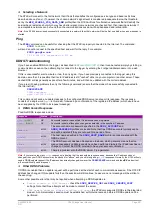
UM-0085-B09
DT80 Range User Manual
Page 220
RG
Note:
Radio emissions from the antenna can interfere with and reduce the accuracy of analog measurements taken by the
DT80
. To
prevent this, the antenna should be positioned at least 500mm away from the
DT80
and any analog sensor wiring.
Network Selection
Service Type
The type of network is reported on the modem status screen, to the left of the signal level bar graph. The system variable
83SV is also updated, as shown in the following table:
Display
83SV
Description
x■■□□
0
GSM only (2G). Internet connection is not available
G■■□□
1
GPRS (2.5G) – low speed packet services are available
E■■□□
2
EDGE (2.5G) – a faster variant of GPRS
3■■□□
3
UMTS (3G) – 3
rd
generation packet network
(DT8xM3 only)
H■■□□
4
HSDPA (3.5G) – 3G network with high speed downlink
(DT8xM3 only)
H■■□□
5
HSUPA (3.5G) – 3G network with high speed uplink
(DT8xM3 only)
H■■□□
6
HSDPA+HSUPA (3.5G) – 3G network with high speed downlink and uplink
(DT8xM3 only)
By default, the
DT80
modem will attempt to connect to the fastest (latest generation) network that it finds (with
preference given to home networks over roaming). You can, however, override this, by setting:
PROFILE HOST_MODEM SERVICE=
service
where
service
can be:
•
AUTO
– connect to the network that will provide the best performance
•
3G
– connect to a 3G network only
•
3G_PREFERRED
– connect to a 3G network; if none available then connect to a 2G network
•
GSM
– connect to a 2G network only
•
GSM_PREFERRED
– connect to a 2G network; if none available then connect to a 3G network
In most cases
AUTO
is the best choice. However, if you are in an area where you know that the 3G coverage is poor or
nonexistent then limiting the networks to 2G may provide a more reliable connection and may slightly reduce the time
taken to register on the network, as the modem no longer has to search for 3G networks.
The above setting is not applicable for DT8xM2 models, which support GSM only.
Bands
Each mobile network operates on a particular radio frequency
band
. (For example, in Australia the Telstra NextG™
UMTS network operates on the 850 MHz band.)The
DT80
supports mobile networks using the following bands:
•
GSM (2G) networks: 850/ 900/ 1800/ 1900 MHz
•
UMTS (3G) networks: 850/ 1900/ 2100 MHz
(DT8xM3 only)
By default, the
DT80
will connect to networks using any of these bands. However, in some situations, you may wish to
restrict the
DT80
to only use certain bands, which will mean that it will then only be able to connect to networks that use
those bands. For example, you could use this to prevent the
DT80
from ever roaming to another network (assuming that
the other network uses a different frequency band).
To select the allowed bands, use the
dEX
Modem
settings page, on the
Network capabilities
tab. The equivalent profile
settings are as follows:
Allowed bands
Profile Setting
GSM 850 MHz only
PROFILE MODEM GSM_BANDS=0
GSM 900 MHz only
PROFILE MODEM GSM_BANDS=1
GSM 1800 MHz only
PROFILE MODEM GSM_BANDS=2
GSM 1900 MHz only
PROFILE MODEM GSM_BANDS=3
GSM 850/1900 MHz
PROFILE MODEM GSM_BANDS=4
GSM 900/1800 MHz
PROFILE MODEM GSM_BANDS=5
GSM 900/1900 MHz
PROFILE MODEM GSM_BANDS=6
GSM 850/900/1800/1900 MHz
PROFILE MODEM GSM_BANDS=7
(default)
UMTS 2100 MHz
PROFILE MODEM 3G_BANDS=1
UMTS 1900 MHz
PROFILE MODEM 3G_BANDS=2
UMTS 1900/2100 MHz
PROFILE MODEM 3G_BANDS=3
UMTS 850 MHz
PROFILE MODEM 3G_BANDS=16
UMTS 850/2100 MHz
PROFILE MODEM 3G_BANDS=17
UMTS 850/1900 MHz
PROFILE MODEM 3G_BANDS=18
UMTS 850/1900/2100 MHz
PROFILE MODEM 3G_BANDS=19
(default)
















































